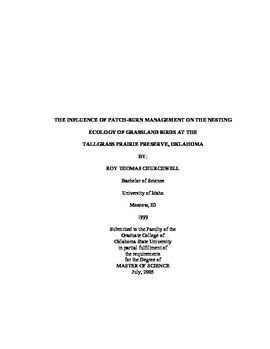| dc.contributor.advisor | Davis, Craig A. | |
| dc.contributor.author | Churchwell, Roy Thomas | |
| dc.date.accessioned | 2014-04-17T20:13:17Z | |
| dc.date.available | 2014-04-17T20:13:17Z | |
| dc.date.issued | 2005-07-01 | |
| dc.identifier.uri | https://hdl.handle.net/11244/10323 | |
| dc.description.abstract | Fire and Grazing were the driving forces shaping the tallgrass prairie before European settlers inhabited the Great Plains. Areas that had not recently burned were more likely to burn due to an increase in litter cover, and areas that recently burned were preferentially grazed by native grazers such as bison (Bos bison). This fire-grazing interaction created a "shifting mosaic" on the prairie landscape of spatially and temporally changing patches. This thesis investigates the implementation of a prescribed fire and grazing strategy that mimics historic fire and grazing patterns in the tallgrass prairie ecosystem using patch-burning. Patch-burn grazing mimics the historic fire regime by spatially and temporally restricting the burning of livestock pastures and pastures are burned in one-third increments each year. This study compares patch-burn grazing with a traditional treatment - the prevalent pasture management in the region where the entire pasture is burned every spring. Study plots were placed in each of the three burn patches of the patch-burn pasture and one in the traditional pasture, and the study had two replications in the study design. Each study plot consisted of a 16-ha nest-searching plot and a 5-ha territory mapping plot located within the nest-searching plot. Data were collected on 3 focal species common to the area: dickcissel (Spiza americana), grasshopper sparrow (Ammodramus savannarum), and eastern meadowlark (Sturnella magna). The objectives of the study were to compare nesting success of these species between grazing treatments as well as gather information about the nesting ecology of the study species. I found that nesting success of these species declined in areas burned during the current year, and due to this, unburned areas acted as a refuge having greater productivity. The traditional treatment had some of the lowest estimates of nesting success even though bird density in this habitat was as high as that of unburned areas. Certain vegetation characters seemed to improve the nesting success of some species, for example areas of greater vegetation height had higher nesting success for dickcissels. I also found our 3 study species tended to prefer more homogeneously structured habitats within this community. My study demonstrates that recreating a "shifting mosaic" within a tallgrass prairie ecosystem is beneficial to grassland birds. | |
| dc.format | application/pdf | |
| dc.language | en_US | |
| dc.publisher | Oklahoma State University | |
| dc.rights | Copyright is held by the author who has granted the Oklahoma State University Library the non-exclusive right to share this material in its institutional repository. Contact Digital Library Services at lib-dls@okstate.edu or 405-744-9161 for the permission policy on the use, reproduction or distribution of this material. | |
| dc.title | Influence of Patch-burn Management on the Nesting Ecology of Grassland Birds at the Tallgrass Prairie Preserve, Oklahoma | |
| dc.type | text | |
| osu.filename | Churchwell_okstate_0664M_1440.pdf | |
| osu.college | Arts and Sciences | |
| osu.accesstype | Open Access | |
| dc.description.department | Wildlife Ecology | |
| dc.type.genre | Thesis | |
